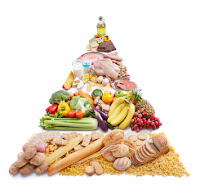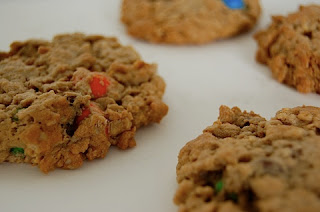
Last year, I would be sitting in my Food Systems Management class about this time of day. When I say sitting, I purposely exclude the words "paying attention." I didn't dislike my food service classes, but I definitely underestimated their usefulness. I underestimated it even more as my senioritis kicked into full gear that fourth and final fall quarter. At the time, I agreed a dietitian should be familiar with how a kitchen is run and know time and temperature control. However, I was more interested in learning about clinical nutrition and things such as medical nutrition therapy, counseling, and education.. Needless to say those previous sentences were fluff to cushion this upcoming sentence: I did not pay attention in my food systems management class. I had already taken a two part series about food service and had learned all I thought I needed to know about the topic. Food systems management covered topics such food purchasing, HR/employee management, and inventory. I was not amused.
An educational film from the 1980's was brought into this class about the Disney Corporation's unique method of employee management. I was literally banging my head on my desk wondering why I had to watch a movie about this-I was a nutrition major, not a business major. To me this was something so unnecessary and outdated it needed to be rewound before watching. I should be learning about the DASH diet* or metabolic syndrome**. In hindsight and a safe distance away from my brooding senioritis, today I will tell you the film is actually pretty interesting and educational; Disney calls their employees "cast members" and treats them as such. They must be doing something right because Disney employees are always extremely friendly, happy, and helpful. The film might have been made in the 80's, but the system Disney uses is so successful it is still implemented today. However back then I didn't realize the connection of employee management to dietetics.
Now that I am part of a system, I see that management is essential. RD's, techs, clerks, hosts, and kitchen staff are all part of a system. Some of the RD's may never meet our prep cook or dishwasher. I don't directly work with the a lot of the RD's . However we are all still connected. For example, an RD will meet with a patient in surgical who just had jaw surgery and puts them on a temporary clear liquid diet. (Hosts don't see NPO or liquid patients because their meal is pretty much already selected) The tech will receive the diet order from the RD and create the patient's dinner order. Kitchen workers on tray line will put this meal together (i.e. jello, juice, popsicle, tea). The clerk will double check the appropriate items are on the tray. The host will deliver it to the appropriate patient. Maybe the RD meets with a patient in telemetry recovering from a heart attack and puts them on a cardiac diet. The host would see this patient and help them choose a meal with minimal non-fat dairy products, lean meats, diet salad dressing, and no caffeine or margarine. The tech gets the order in their computer, the tray is made by kitchen staff, clerk verifies tray, and full circle-host delivers the tray.
What I'm trying to get at here is even if you're not the dietitian that supervises the system, you must understand how it works if you are a part of it. Without a system, the RD would have to meet the patient, make an order, cook the food, make a tray, and deliver it. A system is much more efficient! Said RD may not know the cook making the food or the host delivering it, but they are still connected by the system. If you are the supervisor of the system, you definitely need to understand system management. This includes managing employees' hours, wages, and work ethic. It also includes meals made per day and accounting. To get a better idea of employee organization in a hospital system, here is a possible outline of organization.
I. VP Operations: da boss
A. Dietary Department Director: usually an RD that is the face of the department. The
director communicates with other vice presidents in the hospital and receives complaints
and praise from patients and other departments. Oversees all activity in the cafeteria
and with patients. The director is held responsible anything dietary/food related.
1. Administrative Assistant: I like to think of this position as the eyes and ears in the
kitchen for the director. While the director may be dealing with a patient complaint or
communicating with another department, the admin assistant will be keeping an eye
out in the kitchen or going through orientation with a new dietary employee.
2. Clinical Dietitian Supervisor: this RD sees patients but is also the supervisor for
employees in the dietary office. The supervisor holds meetings and creates the work
schedule for hosts, techs, and clerks. They will also make sure daily tasks are
completed in a timely manner and employees must inform their supervisor if they are
running behind and need to work overtime.
a. Registered Dietitians: see patients and gives consultations on diets (don't let that
short description fool you, there's a TON more RD's do with the inpatient world)
b. Dietetic Technicians Registered: DTR's work in the dietary office and receive
meal selections and requests from patients from the computer system via the
hosts. They will verify that the selections and requests are appropriate to the
patient's diet order and will alter the meal if necessary. For example, the host may
have input an inappropriate amount of carbs for a diabetes order or juice for a
fluid restriction patient. DTR's must have a certification for this position.
c. Host/Hostess: interact with patients to make meal selections and deliver trays.
d. Diet Clerk: assist technician with printing and balancing meal selections. Runs
tray line and is the last person on tray line to make sure the tray is correct.
3. Kitchen Supervisor/Buyer: oversees cooks and food service workers, manages
inventory, and makes food purchases.
a. Lead Cook
i. Cook
ii. Grill Cook
iii. Floaters
iv. Food Service Workers: assist in kitchen and restock snacks and juices in on
floor kitchens in each unit, work in tray line production
v. Storeroom Clerk: organize store room, bring in new products following FIFO
(first in first out), disposing of expired items
4. Evening Lead: the kitchen is busiest and has the most people working from 5 am
to 3 pm. This is when orders are taken, food is prepped for the day, and breakfast
and lunch is served. Patients tend to be discharged in the afternoon, so the hours
between 5-3 are when the bed count or patient quota is highest. Therefore there is a
distinction for evening staff that don't work during peak hours.
a. Vietnamese Chef: depending on the location of the hospital, there may be a
strong need for a specific cultural type of food (i.e. Vietnamese, Kosher, etc).
Vietnamese food may have items such as porridge, won ton soup, tofu, stir fry, etc.
b. Food Service Workers: deliver dinner trays since hosts are not working
c. Dishwashers
d. Cleaners
5. Cafe Lead: In charge of cafeteria where hospital employees and visitors may choose
to eat their meals. May also include catering for hospital events or conferences.
a. Food Service Workers/Cafe Staff: serve customers and use cash registers
My next post will be related to all of the fun management equations I didn't pay attention to in class last year that will now be on my DTR exam...long story short to all you seniors out there-pay attention in food systems!
*DASH diet: recommended for stopping hypertension, focuses on eating more fruits and vegetables, whole grains, lean proteins, Mg, K, and Ca. Eat less saturated fats, red meats, sweets.
**Metabolic Syndrome: three or more of the following symptoms-hyperglycemia (diabetes), abdominal obesity, hypertriglyceridemia (high cholesterol), reduced HDL (the "good"/you want it to be high) cholesterol <40 for men, or hypertension (high blood pressure) above 130/8- mm hg
http://www.theclassroompost.com/2010/03/is-there-cure-for-senioritis.html
















